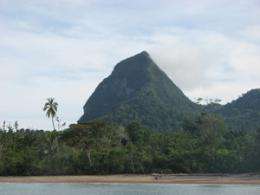New findings explain the mystery behind the development of the Banda arc

(PhysOrg.com) -- The Banda arc - a gigantic 1,000km long, 180-degree curve in eastern Indonesia - has puzzled geologists for many years, with much debate and controversy surrounding its complex origin and evolution. A solution to this enigma, resolving many of the previous problems, has finally been found by scientists at Royal Holloway, University of London and Utrecht University, and is published in Nature Geoscience this week.
Situated at the centre of three converging and colliding major tectonic plates - India-Australia, Eurasia, Pacific - the Banda arc comprises young oceanic crust enclosed by a volcanic inner arc, outer arc islands and a trough parallel to the Australian continental margin. It is a complex subduction setting (where one plate moves under another, sinking into the Earth’s mantle), with possibly the largest fold on Earth, extending to a depth of about 650km, in a subducted plate.
Despite the evidence of modern subduction, marked by many earthquakes and active volcanoes, the history of the Banda arc has not been resolved. The number of slabs being subducted has not even been agreed, with two “schools” offering one- or two-slab interpretations with problematical models of evolution. Using detailed reconstructions of the region - including analysis of tectonic evolution and seismic tomography - Professors Robert Hall, Royal Holloway, and Wim Spakman, Utrecht University, have proposed a solution to the history of the Banda arc involving the rollback of a single oceanic slab.
Indonesia is a region of rapid plate convergence and it was movement of the India-Australia plate northwards that caused the 2004 tsunami which devastated areas around the Indian Ocean. The researchers’ findings demonstrate that slab rollback at high speed is possible in such a convergent setting and explains why the Banda region is deforming as it does today.
They also discovered that there was more subducted slab in the mantle than predicted by reconstructions, and propose that this includes some of the lower part of the Australian plate that has partly separated from the continental crust surrounding the Banda arc. “The subducted slab is now acting as an obstacle to the Australian plate moving north and therefore it has become deformed into a fold in the mantle down to 600km depth which is gradually getting tighter and tighter, with the two limbs of the fold getting steeper and closer together. This is causing the crust to deform,” says Professor Hall.
This deformation has contributed to the rapid elevation of the islands in the Banda arc, the largest of which are Seram and Timor, both of which have emerged from several kilometres below sea level to their present elevations - up to about 3 km above sea level - in the last couple of million years.
“These are remarkable vertical movements on geological time scales,” explains Professor Hall. “In the Banda region we are seeing a mountain belt forming before our eyes - in geological terms - which is why it is so interesting to us. Some of the features we observe there will help us to understand older mountain belts. Professor Spakman′s seismic tomography work, an area of study in which he has been a pioneer, has provided critical evidence and has enabled us to propose some new ideas that we think help explain much of what previously was not understood.”
The researchers’ solution to this longstanding geodynamic problem provides a new basis for understanding the past and present geology and geophysics of the region. Importantly, their findings show that the Banda arc subduction is not the result of a unique tectonic setting but has many past and present analogues around the globe, particularly in regions with (partially) land-locked oceanic basins, such as the Alpine-Mediterranean region, and Central America.
Provided by Royal Holloway, University of London


















